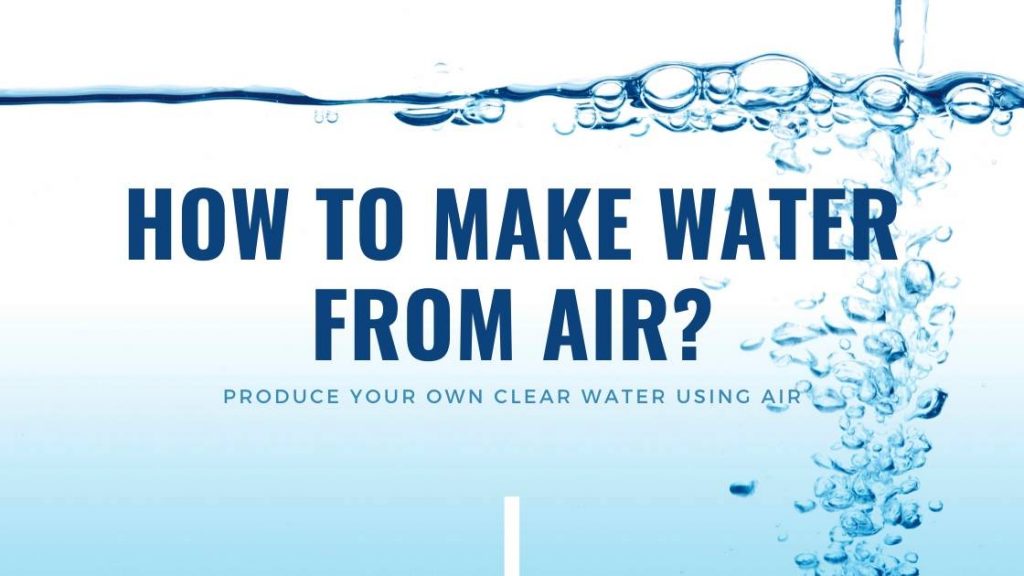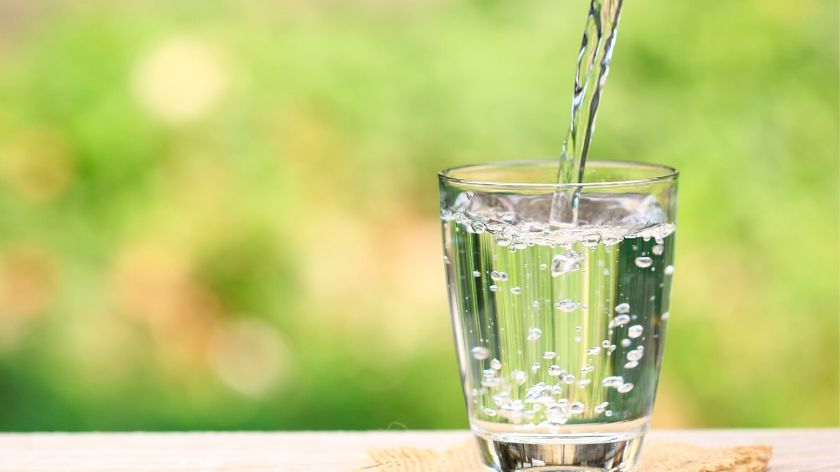
Wondering How to Make Water from Air?, this post will reveal how to make it.
AWG, an Atmospheric Water Generator, is a device that extracts atmospheric water from the air. Using the condensation-cooling method, the water vapor in the air can be extracted by pressurizing the air, divulging the air to desiccants, or cooling the air below its condensation point. AWG is different from the dehumidifier; it is designed to purify the water to potable water. Atmospheric Water Generator is very helpful, where it is difficult to get pure drinking water. This device can easily extract a small amount of water from the air, and to extract two main techniques is used that includes desiccants and cooling.
A substantial input of energy is needed to extract atmospheric water. Some of these AWG systems are completely inert as they completely depend on natural temperature changes, and they don’t use external energy sources. According to the Biomimicry studies, the scurry Stenocara Gracilipes can perform the job naturally.
Most of these AWGs work similar to dehumidifier works, in which the air is passed by a cooling coil, which condenses the water. The production of water depends on the circulating humidity, temperature, the capacity of the machine to cool the coil, and the amount of air passing above the coil. It is the most standard technology that has been in use to extract water from the air, but when driven by coal-based electricity, it leaves out the carbon trails of any water source, and it claims four-times more water from the supply chain than it supplies to the user.
The other alternative technology available to extract water from air uses ‘wet’ or ‘liquid’ desiccants like lithium bromide or lithium chloride to extract water from the air through hygroscopic processes. A similar projected technique combines the use of solid desiccants like zeolite and gel, using pressure condensation. The devices that extract direct drinking quality water use sunlight, but they are still under development stage.

Table of Content
Cooling Condensation
The Cooling Condensation AWG, in this system, a compressor distributes container through a condenser, and the evaporator coil cools the surrounding air. This AWG type lowers the temperature of the air to the dew point, which condenses the water. The filtered air will be pushed by the controlled-speed fan over the coil. This process makes the water pass into a holding tank with filtration and purification system to maintain the clean water and lessen the risk caused by bacteria and viruses, which might be gathered from the surrounding air on the evaporator coil by the water condensing.
The amount of water that can be delivered will depend on surrounding air temperature, relative humidity, and the compressor size. AWG (Atmospheric Water Generators) works efficiently when the air temperature and relative humidity increases. As a criterion, Cooling Condensation AWG does not work effectively when the relative humidity drops below 30-percent or the temperature drops below 65°F. That means CC AWG’s are relatively unproductive when placed inside air-conditioned offices. Also, the AWG type’s price depends on the machine capacity, temperature conditions, and confined humidity; also, it depends on the unit’s power cost.
According to the recent reports, the attempts made to use the Peltier influence of semiconducting materials wherein on the side of the semiconducting materials cools and the other side heats. In this system, the air is pushed over the cooling fans on the cools side that reduces the air temperature to its dew point, which further causes water to condense, and later the water will be collected. Because of the solid-state type of the semiconducting material, it is more convenient for portable units even with the low efficiency of water condensing at normally qualified humidity combined by the Peltier coolers high-power consumption.
The drinking water system capacity can be increased in low humidity circulating air conditions, first with an evaporative cooler with a salty water supply to enhance the air humidity close to dew point condition. Consequently, the drinking water is produced with salty water without relying on the water generator’s circulating air humidity.

Wet Desiccation
One method of WDWG (Wet Desiccant Water Generation) includes the use of salt in an intense saltwater solution to capture the circulating humidity. These generator systems extract the water from the saltwater solution and filter it for consumption. A form of this technology was created as transportable equipment that operates with generators. Bigger versions are placed on trailers, and they produce up to 1,200gallons of water every day and consumes one gallon of fuel for every 5gallons of water. This system was used by the US Navy and the US Army from the FEMA (Federal Emergency Management Agency) and Terralab.
A different system or technology has been produced to be more eco-friendly, and the system mainly runs on passive solar energy and gravity. Saltwater is gushed down the exterior of towers, where it collects water from the air. The saltwater then goes through a chamber and is exposed to a limited heated and vacuum. The water vapor is abridged, and the liquid water gathered, and the transformed saltwater is recalculated through the system. As the condensed water is taken out from the system using gravity, it produces the vacuum that decreases the boiling point of the saltwater.
Water from Air

Water Freedom System is an Atmospheric Water Generates, which creates water using their registered advanced air-to-water technology that generates unlimited, pure drinking water from the air.
How does it work?
The most resourceful source of pure and freshwater is the Earth’s air. When atmospheric humidity reduces, it falls as rain. Water Freedom System reproduced this natural condensation process by replicating the dew point that makes the system produce water continuously during the low humidity conditions. The AWG system’s unique technology is that they use advanced dehumidification techniques to derive and reduce moisture in the air to create purified, healthy drinking water.
The air contains around 37.5billion gallons of water. The hydrological cycles maintain water vapor and air and make it a nearly indefinite source of water.
Learn More About The Water Freedom System
Operating Environment
Water Freedom System AWGs rely on temperature and humidity, and it is installed in the environmental setting. When the humidity increases, the output also increases similarly if the humidity decreases, the output also decreases. Warm coastal regions with high humidity are perfect areas to extract water from the air.
Water Freedom System’s air-to-water devices extract drinking water from the air, and no other water source is needed. Their registered technology is distracting the water market. The system produces water by combining heat, atmospheric humidity, and airflow through air-to-water function, generating 5,000lts to 20,000lts per unit in a day.
Water Freedom System Air-to-Water solutions are:
- Resourceful
- Environmentally and socially supportable
- Scalable and cost-effective
- Applying unique technology
Resourceful
The Water Freedom System is a portable and modular system that is decentralized and distributed and offers wide application use cases. Also, this system is versatile as it provides quick guard deployment.
Environmentally and Socially Supportable
The Water Freedom System is a completely environmental and socially sustainable system that is free from chemicals, access to pure water, energy agnostic, grid, solar, wind, hybrid or diesel, zero to very little carbon footprint, and saving lives.
Scalable and Cost-Effective
The Water Freedom System is affordable AWG that gives you easy access solutions by adding more units. It is not reliant on local structure, and it doesn’t need a large capital from customers. The water system procedures increase energy use.
Proprietary Technology
The Water Freedom System applies unique technology as it is an advanced film purification and waste heat recapturing system, which comes with interacted observing and control system. The system reuses water using a closed-loop method. The requirement for Water Freedom System’s air-to-water abilities is clear.
The main applications for their air-to-water technologies are settings that don’t get access to any water sources.
They include:
- Beverage/Bottle Industry
- Remote and Island Communities
- Industrial and Medical (combination with WW technology)
- Temporary charitable applications in war or disaster zones
- Charitable applications in conventional regions of water scarcity
- Commercial CSR programs
Conclusion
It is possible to extract water from the air from any surroundings. Water Freedom System unit uses a generator that pushes air into a heat exchanger, where the air gets condensed and cooled. A combination solution, including wind, grid, and solar, can be installed to extract water using a powerful ventilation system.
To lower the temperature, it needs minimal energy, and when the temperature drops below the dew point, droplets of water will form. These water droplets are then collected in a water storage chamber.
The Air-to-water water production system depends on the atmosphere. The amount of water extracted from a specific location will depend on the ambient temperature, average wind speed, and relative humidity.
To make the AWG system work under any conditions, the generator can be modified to an environment where it is used, like adjusting the height of the tower and the blade diameter to increase the unit’s efficiency. The generator can also be connected with solar or conventional power to increase water production. Water Freedom System units are the best option as they use renewable energy and are obtainable in different sizes to extract water from the air.
I have tried to buy your system 3 times with thee different credit cards and to no success. How can I get in touch with you to give you cash?